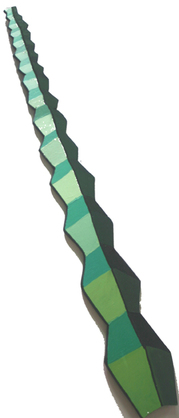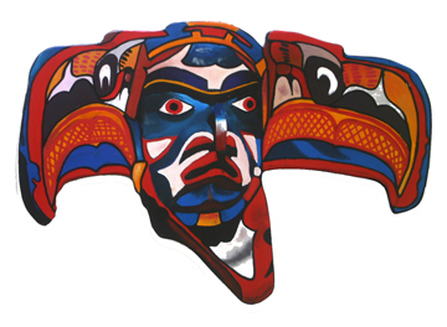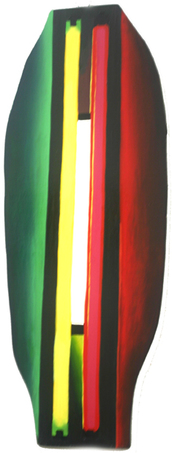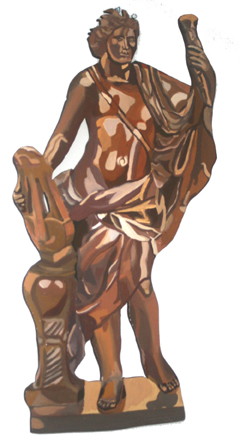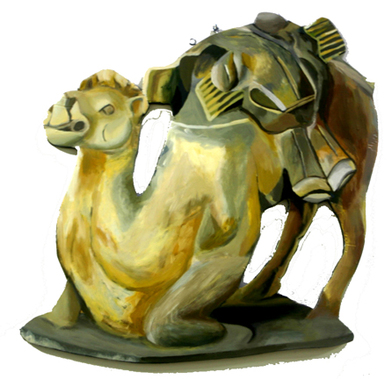|
Standing Figure
Paul T. Cassedy Standing Figure Unknown Artist circa 1200 B.C. Bronze Method: Bronze Casting Subject: A stylized figure standing 8’ 5” tall on a platform formed of animal heads. Reason: The reason for this piece is unknown but it was the most dramatic piece found in the excavation of Guanghan Sanxingdui, and the only known representation of a human figure on this scale. |
|
Endless Column
Paul T. Cassedy Endless Column Constantin Brancusi 1938 metal-coated cast-iron modules Method: 15 steel beads were made and then threaded onto an iron core. Subject: Geometrically shaped beads stretching towards the sky. Reason: This sculpture was created in memory of the Romanian soldiers who died in World War 1. It forms an ensemble with 2 other pieces, the Table of Silence, and the Gate of the Kiss. |
|
Kwakiutl
Alert Bay Sarah Davis Late 19th century Wood, feathers, rope, and paint Method: Wood Carving Subject: Animals and mythological creatures Reason: This (Northwestern Coast) mask was created for males to use in their dramatic public performances in the winter ceremonial season. Masks similar to Kwakiutl were meant to be seen in flickering firelight, while it rapidly opened and closed. This created the illusion that the wearer could transform himself from human to eagle as he danced. |
|
Dan's Rico
Sarah Davis Puerto Rican Light Dan Flavin 1965 Red, pink, and yellow fluorescent light Method: Arranged fluorescent lights to make a figure Subject: Time Reason: This display was made to create a unique environment that consists of eternity and neutrality. The contrast between the fluorescent lights and the wall emphasizes the darkness. The lights are bunched together to highlight the colors as intensely vivid. As stated by Robert Smithson, “Flavin turns gallery space into gallery time.” Dan Flavin displayed his unique style through his Puerto Rican Light, where it is stressed that the piece can disappear at any moment when the light switch is turned off. |
|
Francois Girardon
Abigail L. Faelnar Apollo circa 1675 A.D. Bronze Cast Method: Terracotta Subject: Apollo the sun god, who was also the symbol of Louis XIV Reason: This piece, because of its scale and detail, was most likely a finished model of a sculpture to be presented for a patron’s approval. Francois Girardon based Apollo on a sketch created by the first painter of Louis XIV, Charles Le Brun. Perhaps this specific piece was created for palace at Versailles because not only was the sun god a symbol of Louis XIV, but also because the king was the main source of the sculptor’s commissions. |
|
Camel
Abigail FaelnarEastern Wei Dynasty (534–550), Earthenware Method: Clay Subject: Sculpture of a kneeling camel Reason: This piece was one of the two distinctive camel sculptures excavated in 1979 from the tomb of the Princess Lihne (538-555). The camel carries rolls of cloth and saddlebags and the resting of the left knee signify that the camel is either kneeling down or standing up. The tomb of the Ruru Princess was located in the Hebei Province in China, and from the fifth to the eighth century, sculptures were standard in burials. Princess Lihne’s own tomb contained over 1,640 sculptures. |
|
Double Flute Player
Jessica Haynsworth Double-Flute Player Artist Unknown circa I-II millenium B.C. Marble Method Hammer and chisel Subject Parian marble idol, from Keros Reason This idol was created for funerary purposes. The reason for this belief is because the way the feet were positioned indicates that it was not meant to stand up. The size is no more than three centimeters long and was created from bleached white rock. The idol is very primitive, carved into geometric shapes such as triangular noses and flat ears. The interesting and artistic thing about this piece and other marble idols from the time were that they bear no anatomical resemblance to an actual human body, making it very abstract. This idol was one of the first at the time to be created using simple proportions based on relationships between the different parts of the body. |


